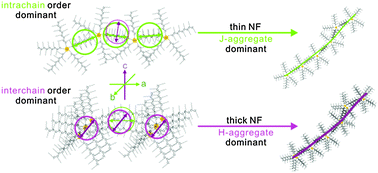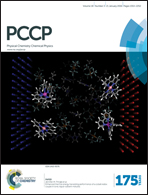Formation and decay of charge carriers in aggregate nanofibers consisting of poly(3-hexylthiophene)-coated gold nanoparticles†
Abstract
Thin nanofibers (NFs) of J-dominant aggregates with a thickness of 15 nm and thick NFs of H-dominant aggregates with a thickness of 25 nm were fabricated by the self-assembly of poly(3-hexylthiophene)-coated gold nanoparticles. The formation and decay dynamics of the charge carriers, which are dependent on the aggregate types of NFs, was investigated by time-resolved emission and transient-absorption spectroscopy. With increasing excitation energy, the fraction of the fast emission decay component decreased, suggesting that the fast formation of polaron pairs (PP), localized (LP), and delocalized polarons (DP) results from higher singlet exciton states produced by the singlet fusion. The faster decay dynamics of DP and LP in the thick NFs than in thin NFs is due to the increased delocalization of DP and LP. As the interchain aggregation is weaker than intrachain aggregation, PP decays faster in thin NFs than in thick NFs. In both thin and thick NFs, although triplet (T1) excitons were barely observed with excitation at 532 nm on a nanosecond time scale, they were observed with excitation at 355 nm, showing that T1 excitons within NFs are generated mainly through the singlet fission from a higher singlet exciton state rather than through intersystem crossing.


 Please wait while we load your content...
Please wait while we load your content...